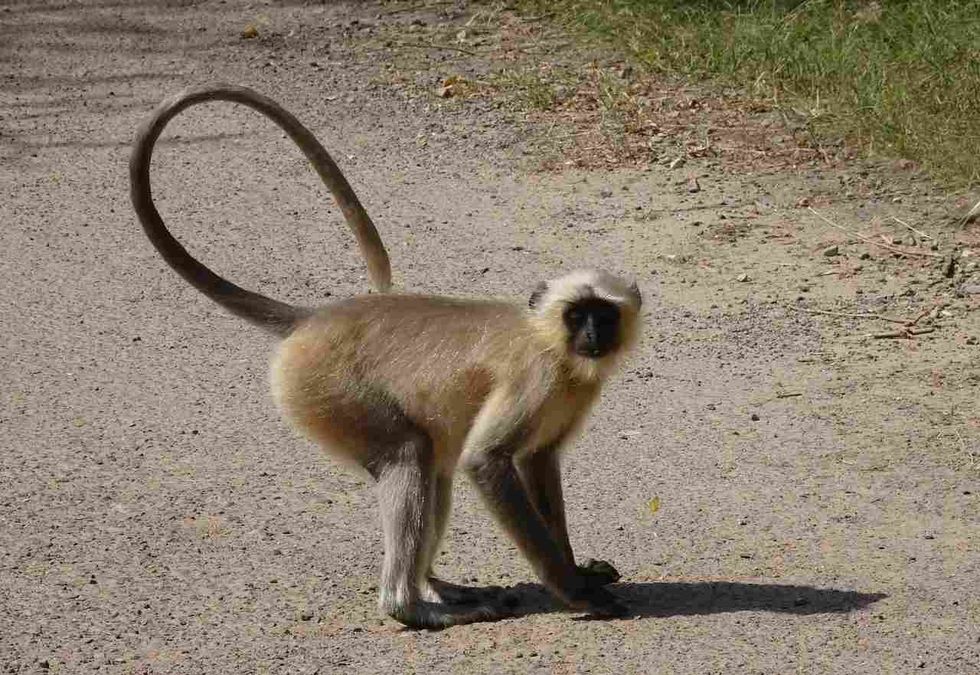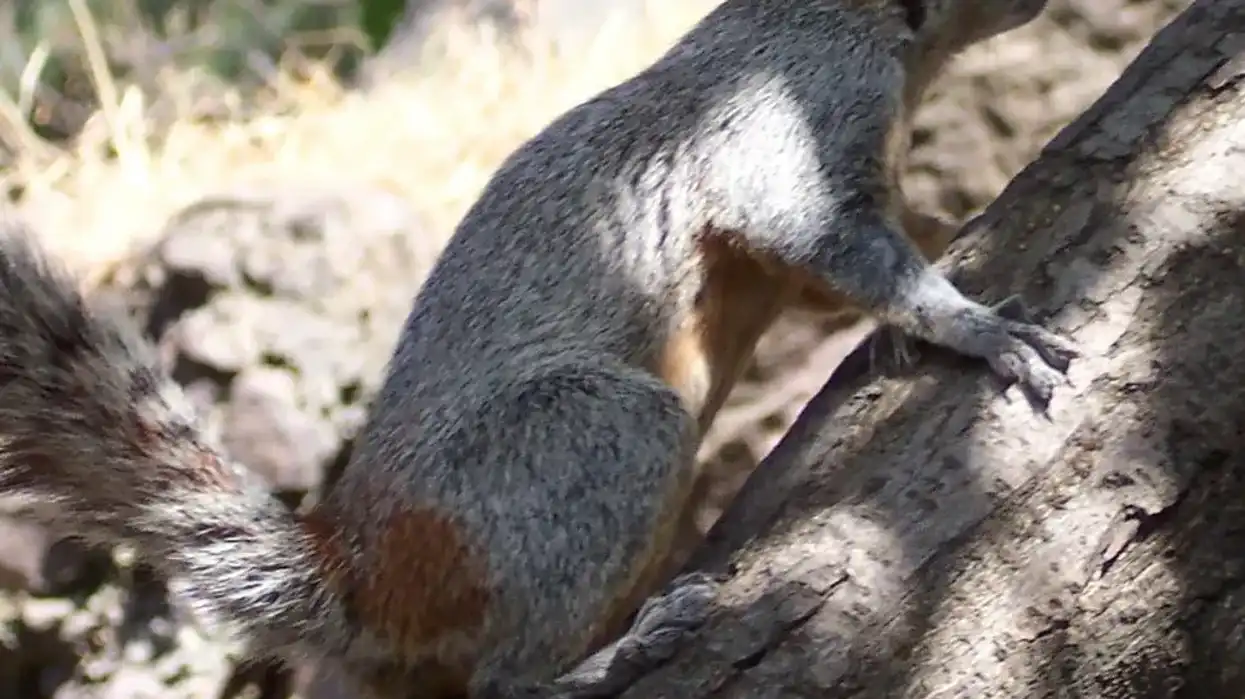The gray langur is a common sight in the dry deciduous forests and human settlements of India, Bhutan, Nepal, Bangladesh, Tibet, Sri Lanka, and Pakistan. One of the most common gray langur species, the northern plains gray langur (Semnopithecus entellus), is also known by other names such as the Hanuman langur, Indian langur, Bengal langur, and the sacred langur.
Hanuman langurs belong to the group of Old World monkeys and the genus Semnopithecus, which also includes seven other species of gray langur such as the Kashmir gray langurs (Semnopithecus ajax), the Madras gray langur, or the tufted gray langurs (Semnopithecus priam), Tarai gray langurs (Semnopithecus hector), the Nepal Gray langurs (Semnopithecus schistaceus), the black-footed gray langurs (Semnopithecus hypoleucos), the Nilgiri langurs (Semnopithecus johnii), and the purple-faced langurs (Semnopithecus vetulus).
With a strikingly different physical appearance from the common monkey, gray langur monkeys or Hanuman langurs, spend a part of their time on the ground and a part on trees.
Their face and ears are typically black, and the body fur is predominantly gray or yellowish. The gray langur monkey is herbivorous and diurnal; it sleeps during the night and remains active throughout the day.
Adaptable to a wide range of habitats from deserts, tropical, and temperate forests to even high altitude mountains, the Hanuman langurs are a lot of versatile monkey species.
Want to know more about the Hanuman langur? Then read on!
For more relatable content, check out these langur monkey facts and howler money facts for kids.
Gray Langur Interesting Facts
What type of animal is a gray langur?
The gray langur or the Hanuman langur is a primate species and one of the Old World monkeys of the family Cercopithecidae. Baboons are also old world monkeys.
What class of animal does a gray langur belong to?
The gray langur species belongs to the class of mammals.
How many gray langurs are there in the world?
The exact population size of the gray langur species is not known. However, according to the International Union for Conservation of Nature (IUCN) Red List of Threatened Species, most species of gray langurs, including the Hanuman langur (Semnopithecus entellus), have a decreasing population trend.
Where does a gray langur live?
Gray langurs occupy a wide range of environments and habitat types. Primarily forest-dwelling animals, gray langurs can be found in desert regions, tropical rainforests, dry and moist deciduous forests, coniferous forests, riverine forests, scrub forests, grasslands, meadows, mountain foothills, as well as towns, villages, temple grounds, orchards, and agricultural lands.
What is a gray langur's habitat?
Gray langurs are a widespread species of primates that occupy sea levels as well as high altitude areas of up to 13,000 ft (4,000 m). They are flexible and can adapt to a wide range of habitats.
The Nepal gray langur and the Kasmir gray langur are examples of gray langur species that can be found at higher elevations. In general, the geographic range of the different Semnopithecus species is spread throughout India, Pakistan, Nepal, China, Bhutan, Bangladesh, and Sri Lanka. Some populations may exist in Afghanistan as well.
Who do gray langurs live with?
Gray langurs have a complex social structure and can exist in different types of groups; one-male groups consist of one male, several females, and their offspring, multiple-male or multiple-female groups comprise several males and females, and all-male groups have only mature and immature males in them.
The group size differs with the type of group and may generally have 11-64 individuals or 2-17 members for all-male troops.
Dominance in all-male groups is decided by mating success and achieved through aggression. These all-male groups may undergo periodic changes and replacements with a resultant reshuffling of social ranks. In comparison, the membership within female groups is more or less stable, with friendlier relationships between members.
The social ranking among females is decided by the age and physical condition, with younger ones being of higher ranks. Females in a group engage in activities like traveling, resting, foraging, and grooming.
These female monkeys are quite often seen grooming the male monkeys. The relationship between males and females is positive. Inter-group relationships may be hostile and bitter, with the high-ranking males from different groups fighting among themselves.
How long does a gray langur live?
In the wild, the Hanuman langur's lifespan can range between 18-30 years. Females usually have a longer lifespan than males.
How do they reproduce?
The breeding season of the gray langurs varies regionally but usually takes place between July and October. Adult females give birth between February and April.
Females reach reproductive maturity at about three years of age, and the males do so when they are around five years old. In one-male groups, the single male alone fathers all the offspring in the troop, and in multiple-male groups, it is usually the highest-ranking male that breeds the most number of females.
The gestation period is about 200-212 days. After the gestation period is over, the females give birth to a single infant.
While a single infant is most common, twins may also be born on rare occasions. The female langur takes care of its offspring and may also be helped by other female langurs who have recently become mothers.
The infant Hanuman langurs are weaned between 8-13 months of age and become fully independent by the time they are one or two years old.
What is their conservation status?
As per the International Union for Conservation of Nature (IUCN) Red List of Threatened Species, the Northern plains gray langurs (Semnopithecus entellus) are of Least Concern. Other Hanuman langur species, such as the tufted gray langur (Semnopithecus priam), is Near Threatened and the Kashmir gray langur (Semnopithecus ajax) is Endangered.
Gray Langur Fun Facts
What do gray langurs look like?

The fur of gray langurs is predominantly brownish-gray in color. The fur on the front part of the body is whitish.
The different species of the gray langur vary externally in terms of the presence or absence of a crest, the overall color, and the darkness of the hands and feet. The face, ears, feet, and hands are black, with a frame of white fur around the face.
The tail has a white tip and is usually longer than the body, with an average length of 27-40 in (69-102 cm).
The average combined head and body length of the gray langurs is about 25.2 in (63.9 cm). Adult males are approximately 30 percent larger in size compared to adult females.
How cute are they?
In general, langurs are not really cute. Similarly, gray langurs do not really fit the definition of cute. Their distinctly raised forehead makes it appear as if they are wearing a cap and the dark face makes it particularly difficult to make out their facial features at first glance.
How do they communicate?
Gray langurs are known to have about 19 different vocalizations that range from barks, grunts, whoops, and coughs to screams, grunts, rumbles, honks, and hiccups. Each call is meant for a specific situation. For instance, harsh barks are common when confronted with a predator, and coughs or grunts are heard during group movements.
How big is a gray langur?
The body length of the gray langurs can range between 23-25.2 in (58.5-64 cm), with the average head to body length being about 25.2 in (64 cm). They are almost of the same size as Gee's golden langur (Trachypithecus geei).
How fast can a gray langur move?
No data is available regarding how fast gray langurs can move. However, they are capable of hopping, climbing, and leaping. They can leap 12-15 ft (3.6-4.7 m) horizontally and 35-40 ft (10.7-12.2 m) while descending.
How much does a gray langur weigh?
Gray langur males have an average weight of about 40 lb (18 kg), and females weigh around 24 lb (11 kg) on average.
What are the male and female names of the species?
Male and female gray langurs do not have distinct names.
What would you call a baby gray langur?
A baby gray langur is referred to as an infant.
What do they eat?
Gray langurs are primarily herbivores but may also consume insect larvae, termites, and spider webs. Plant foods include leaves, flowers, fruits, fruit buds, coniferous needles, cones, roots, grass, seeds, lichens, mosses, and bamboo. Gray langurs may also eat human food and forage on agricultural crops if the need arises.
Are they active?
Gray langurs are quite lively and energetic and are active during broad daylight.
Would they make a good pet?
Even though infant gray langurs are absolutely cute and adorable, they grow up to be difficult animals that are not suited for keeping as pets.
Did you know...
Known predators of the gray langurs are golden jackals, wolves, tigers, dholes, and leopards.
The tail of North Indian gray langurs loops towards the head while walking, while those from Sri Lanka and South India carry their tail in an S or U-shaped pattern.
It is believed that the city of Jodhpur in the Indian state of Rajasthan has about a million of these Hanuman langurs.
Why are langurs considered sacred?
The Hanuman langur gets its name from the monkey God Lord Hanuman and is considered sacred by the Hindus. The sacred langur features in the epic Ramayana and is revered and worshipped in India to the extent that their body parts are kept as amulets for good luck and positivity.
Why are monkeys afraid of langurs?
The sheer body size and the long tail of the langurs are believed to scare away the comparatively smaller-sized monkeys.
Here at Kidadl, we have carefully created lots of interesting family-friendly animal facts for everyone to discover! For more relatable content, check out these colobus monkey facts and squirrel monkey facts pages.
You can even occupy yourself at home by coloring in one of our free printable Gray langur coloring pages.









